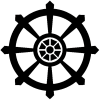Wheel Cross
This cross is composed of waggon wheels and is attributed to (at least) three saints.
(We are indebted to a writer from Portland for information about the first two of these saints. If you know of wheeled crosses attributed to other saints, or if you happen to know the significance of six wheels in this cross, please let us know.)
St. Catherine
Seven Catherines have been granted sainthood, one of whom was the 4th century St. Catherine of Alexandria, Egypt. Not many facts are known about her but it is commonly believed that she was daughter to Costus, the governor of Alexandria.
She became a Christian and tried to persuade the Roman Emperor, Maxentius, to convert to Christianity. She failed, but did succeed in irking the Emperor by persuading his wife and several Pagan elders to convert. Maxentius dealt with this by condemning Catherine to death by the 'breaking wheel'; a torture instrument.
Legend has it that the wheel miraculously exploded when she touched it. So she was decapitated instead.
Catherine's mission in this life was over, but God saw no need for her death to be through the torture of the wheel. Rather, her death, whilst not pleasant, was certainly swift. Her soul was safe, as was the soul of Emperor's wife.
Catherine is the patron saint of wheelwrights, along with St. Eligius and St. Joseph, and her emblem, like the 'Catherine Wheel' firework, is a spiked wheel to remind us that even though we don't know how God works, He nevertheless has a plan for us all.
(See also St. Catherine's Cross)
St. Jarlath (Iarlaithe mac Loga c. 450-540)
There is a legend from the 6th century of a large religious community at Cloonfush (Cluainfois), a few miles outside Tuam (pronounced "choo-um"), a town in County Galway, Ireland. The abbot was Saint Benan of Kilbannon, a disciple of St. Patrick.
One of the monks there, Jarlath, wanted to travel from the community to establish his own monastery. Sounded like a fairly good idea, but Jarlath had no plan where exactly this new monastery should be. In his farewell speech Benan said "Go, and wherever your chariot wheel breaks, there shall be the site of your new monastery and the place of your resurrection" (but in Gaelic of course).

So off he went and sure enough, pretty soon when he got Tuam, a wheel broke. At that very spot, now called 'Temple Jarlath', he founded a Christian settlement (c. 526-527 AD) and began the process of converting those who followed the existing ancient pagan beliefs.
The history of Tuam can be traced back to the Bronze Age, when the area was used by pagans as a burial ground. Introducing Christianity to a place sacred to another religion for 2,500 years was a remarkable feat.
Jarlath was in his 70s when he embarked on his mission but he didn't allow his age to be a hindrance. He did what he believed was right.
In this world of convenience, we are too ready to give up when things appear to be against us. Jarlath didn't give up. To say he made an impression is an understatement. For sure, you are still reading about him 1,500 years later!
A broken cartwheel is now the emblem of the town.
St. Quentin (3rd century)
Quentin is an early Christian saint who died c. 287 AD. He is not the namesake of the infamous and overcrowded San Quentin prison in California, but prison inmates who wish to escape may well be inspired by this saint.
Quentin was a Roman and also known as Quintinus and as Quentin of Amiens. According to legend he journeyed with St. Lucian of Beauvais to Gaul, settling at Amiens in the north. His zealous missionary work there got him into trouble with Rictiovarus, who was by that time quite used to dealing with these troublesome Christians.
Quentin was captured and tortured on the wheel for not recanting his faith. He managed to escape, only to be caught again and this time beheaded. (We don't know if the wheel broke during the torture, but the wheel followed by decapitation is similar to the above story about St. Catherine.)
There's a related legend of a woman called Eusebia, who travelled from Rome in search of Quentin's body. Even though many years had passed, she discovered the body, interred it atop a mountain, and built a small chapel to protect the tomb. One has to assume she had assistance in doing this, not only because she was a woman of nobility, but she was also blind. However, when the task was complete, her blindness was miraculously cured.
Other crosses with wheels
Several other crosses incorporate one or more wheels, and these include crosses found in many parts of Britain and other northwest European areas. The wheel diameter may be longer or the same length as the cross arm. They are commonly known as a Celtic Crosses or Halo Crosses.
Rather than a waggon wheel, the Anchor Cross is sometimes shown with a ship's wheel.
The Korean Unification Church emblem incorporates a cross with the Wheel of Dharma. Other esoteric wheels include the Zodiac and the Kabbalah 'crosses'.
Some crosses have no wheel as such, yet represent rotational movement. These include the Taranis Wheel, often misnamed as a Solar Cross; the north European Woden's Wheel, also called Odin's Wheel; the Tomoe, a Buddhist meditation symbol; and the Swastika.
And finally, a cross with a meaning that eludes us. If you know, please tell us.












